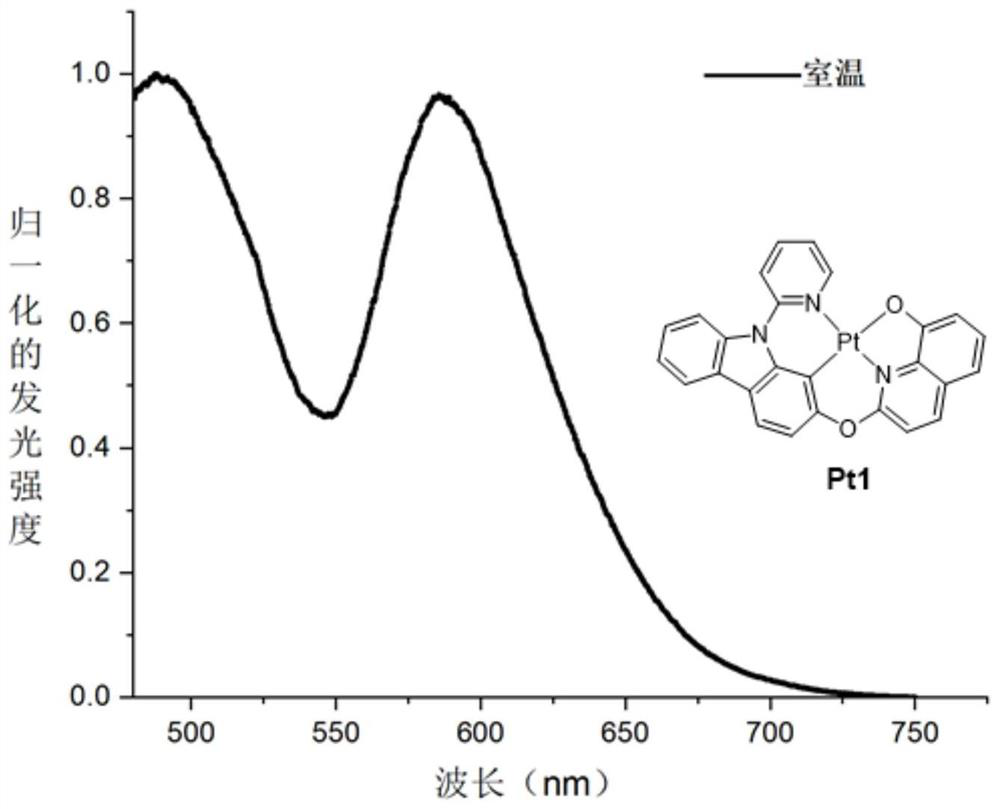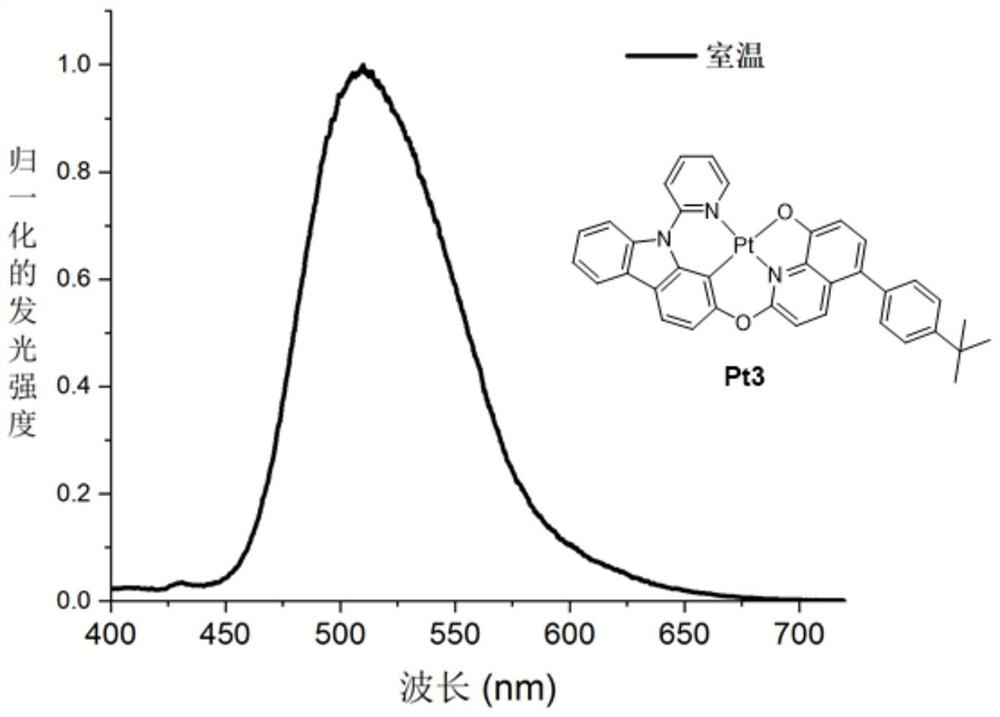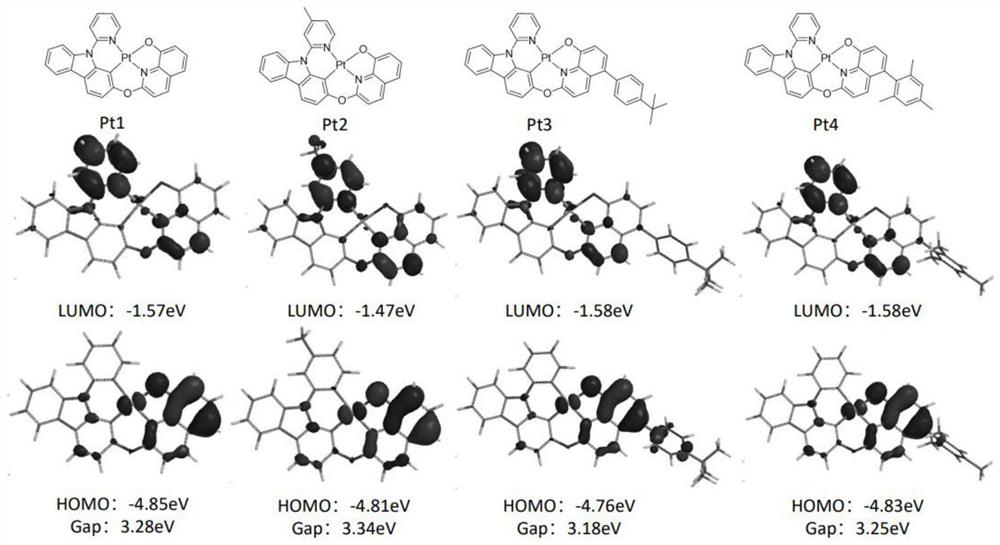Metal platinum (II) and palladium (II) complexes, organic light emitting devices and display or lighting devices
An organic light-emitting device, metal platinum technology, applied in organic chemistry, luminescent materials, electric solid-state devices, etc., can solve the problems of bidentate ligands that are easy to twist, low rigidity, vibration, etc., and achieve non-radiative attenuation suppression and good thermal stability Sexuality and broad application prospects
- Summary
- Abstract
- Description
- Claims
- Application Information
AI Technical Summary
Problems solved by technology
Method used
Image
Examples
Embodiment 1
[0132] Example 1: The platinum complex Pt1 can be synthesized as follows:
[0133]
[0134] Synthesis of intermediate 8-methoxyquinoline: In a 100mL there-necked flask with a magnetic rotor, add 8-hydroxyquinoline (5.00g, 34.5mmol, 1.00 equivalent), N,N-dimethylformamide ( 40mL), then it was placed in a low temperature bath and stirred, and after the temperature was lowered, sodium hydrogen (1.38g, 34.5mmol, 1.00 equiv.) with a mass fraction of 60% was slowly added, and iodomethane (5.14g, 36.3g) was added after being placed at room temperature. mmol, 1.05 equivalents), reacted for 8h. The reaction mixture was quenched by adding ethanol, the solvent was distilled off under reduced pressure, extracted three times with ethyl acetate, the organic phases were combined, dried over anhydrous sodium sulfate, and the obtained crude product was separated and purified by silica gel column chromatography, eluent (petroleum ether) / acetone) = 2:1, and the solvent was distilled off und...
Embodiment 2
[0140]Example 2: The platinum complex Pt3 can be synthesized as follows:
[0141]
[0142] Synthesis of 5-bromo-8-methoxyquinoline: add 8-methoxyquinoline (4.76 g, 29.9 mmol, 1.00 equiv) to a 500 mL there-necked flask with a magnetic rotor, add 230 mL of acetonitrile, and then slowly add N-Bromosuccinimide (5.32 g, 31.3 mmol, 1.05 equiv) was reacted for 8 hours. The reaction mixture was added with aqueous sodium sulfite to quench the reaction, diluted with dichloromethane, extracted three times with dichloromethane, and the organic phases were combined and dried over anhydrous sodium sulfate. The crude product was separated and purified by silica gel column chromatography, eluent (dichloromethane / ethyl acetate = 10:1), and the solvent was distilled off under reduced pressure to obtain 5.8 g of a pale yellow solid with a yield of 82%. used directly in the next reaction.
[0143] Synthesis of intermediate 3-A: 5-bromo-8-methoxyquinoline (500 mg, 2.1 mmol, 1.00 equiv.), p-te...
Embodiment 3
[0149] Example 3: The platinum complex Pt10 can be synthesized as follows:
[0150]
[0151] Synthesis of intermediate L10-Me: add 2-bromo-8-methoxyquinoline (1.00 equiv.), M-10 (1.05 equiv.), CuI (0.1 equiv.), 2 -picolinic acid (0.2 equiv), K 3 CO 4 (2.1 equivalents), after the nitrogen was purged three times, dimethyl sulfoxide was added by injection, the temperature was increased to 120° C., and the reaction was carried out for 48 hours. The reaction mixture was quenched with water, diluted with ethyl acetate, extracted three times with ethyl acetate and dried with anhydrous sodium sulfate. The obtained crude product was separated and purified by silica gel column chromatography, and the solvent was distilled off under reduced pressure to obtain the product L10-Me.
[0152] Synthesis of intermediate L10: add L10-Me (1.00 equiv.), a mixed system of hydrogen bromide and acetic acid to a three-necked flask with a magnetic rotor in turn, and heat up to 120°C for reflux rea...
PUM
| Property | Measurement | Unit |
|---|---|---|
| emission peak | aaaaa | aaaaa |
| thickness | aaaaa | aaaaa |
| thickness | aaaaa | aaaaa |
Abstract
Description
Claims
Application Information
 Login to View More
Login to View More - R&D
- Intellectual Property
- Life Sciences
- Materials
- Tech Scout
- Unparalleled Data Quality
- Higher Quality Content
- 60% Fewer Hallucinations
Browse by: Latest US Patents, China's latest patents, Technical Efficacy Thesaurus, Application Domain, Technology Topic, Popular Technical Reports.
© 2025 PatSnap. All rights reserved.Legal|Privacy policy|Modern Slavery Act Transparency Statement|Sitemap|About US| Contact US: help@patsnap.com



